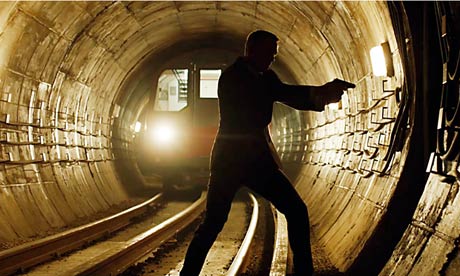During rush hour, the London Underground is as populous as Glasgow. What happens to us when we travel on the tube, and how is this linked to its strange absence from film, TV and novels? John Lanchester investigates

Daniel Craig as James Bond in Skyfall:
'The whole sequence is a fascinating exercise in the limits and difficulties of
depicting the underground on screen.' Photograph: Landmark Media
The first District line train out of Upminster in the morning is the first
train anywhere on the underground network. It leaves the depot at 4.53, the only
train anywhere in the system to set out from its base before 5am. That's a kind
of record: if you catch that train, you might be tempted to say ta-dah! – except
you probably wouldn't, because nobody is thinking ta-dah! at seven minutes to
five in the morning; certainly nobody on this train. People look barely awake,
barely even alive. They feel the same way they look; I know because, this
morning, I'm one of them.
The romantic side of the first train is harder to define. It's something to
do with the secret nightlife of the city, the London that is carrying on while
the rest of London fidgets in its sleep. There's a romance attending on those
jobs, the ones that keep things running all night long: it's part of
the fascination of big cities, the sense that something is always going on
somewhere, even in the smallest of small hours. Bakers and police and nurses and
cab drivers and market porters all belong to that secret city, the one which
rumbles along so late it starts to get early. Once or twice, carrying on a long
evening by going to the place after the place I started, and then to the place
after that, I've ended up in versions of this super-late or super-early London.
I remember once, back in the days when journalism was wilder than it is now,
ending up in the place-after-the-place-after-the-place with a group of sports
desk colleagues: a packed Greek taverna, surrounded by people howling for more
retsina, waiters swerving between tables carrying platters of burnt meat, the
room not merely loud but roaring, and looking at my watch to see that it was
a quarter to four in the morning – and the point that struck me was that
everyone around seemed to regard it as perfectly normal.
The full most interesting story
The Underground Lines series, published by Penguin, is out this week.- box set of all 12 titles (RRP £60),
I've lived in London for more than quarter of a
century now, and this is the first time I've ever been on the day's first train.
It's something I'd often wondered about, though, from both a practical and a
romantic point of view. The practical question was a simple one: if the
transport network isn't running in the early morning, how do the people who
operate it get to work? How does the driver get to the train, if there are no
trains to take him there? The answer is prosaic: they get there by minicab. The
cabs travel a prescribed route to the various depots on the District line,
picking up staff en route as they head to Upminster, Earl's Court, Ealing
Common, Barking and Hammersmith. Of these postings, Upminster is the most
popular, because a large number of drivers live nearby – that's one of the
reasons it is, as I was told by a District veteran, the "senior depot". The
first train out from Earl's Court in the morning is at 5.21, but to get there,
allowing for multiple pickups and some waiting around at the depot, the minicab
from the East End starts as early as 2.30 in the morning. That's an early start
to a working day.
The full most interesting story
The Underground Lines series, published by Penguin, is out this week.- box set of all 12 titles (RRP £60),
No comments:
Post a Comment